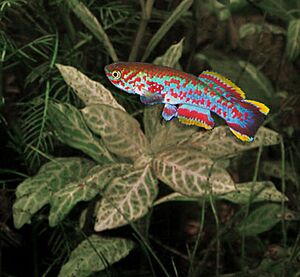Blue lyretail facts for kids
Quick facts for kids Blue lyretail |
|
|---|---|
 |
|
| Two individuals of the nigerianus population exhibiting Sexual dimorphism | |
| Conservation status | |
| Scientific classification | |
| Synonyms | |
|
The blue lyretail (Fundulopanchax gardneri) is a cool type of killifish. It's also known as the Gardner's killi. You can find this fish only in freshwater rivers and swamps in Nigeria and Cameroon.
Contents
What Does the Blue Lyretail Look Like?
Blue lyretails are special because the males and females look different. This is called sexual dimorphism.
- Males are much more colorful than females. They have wavy lines of red spots all over their bodies. Their top, bottom, and tail fins often have yellow edges.
- Females are not as brightly colored. They have brown spots instead of red ones.
Both males and females can grow up to about 6.5 centimeters (2.5 inches) long.
Where Do Blue Lyretails Live?
These fish live in small streams and marshy areas. You can find them in the Benue and Cross River areas of Nigeria and Cameroon.
Life in the Water: Habitat and Habits
Blue lyretails live in both grassy plains (savanna) and forest areas. Male fish are bigger and more colorful, and they have larger fins than females.
Males can be quite territorial, meaning they like to protect their own space.
These fish have a unique way of laying eggs. The places they live can sometimes dry up. So, their eggs are super tough! They can survive even if the water disappears for a while. But they can also hatch if the water stays around. If the eggs are always in water, they usually hatch in about 14 to 21 days, depending on how warm the water is. The fish lay their eggs right on the bottom of the water.
Naming the Blue Lyretail
The blue lyretail was first described in 1911. A scientist named George Albert Boulenger gave it the name Fundulus gardneri. The fish was named after Captain R.D. Gardner, who collected the first fish specimen in Nigeria.
Different Types of Blue Lyretails
There are a few different kinds, or subspecies, of the blue lyretail:
- Blue lyretail – Fundulopanchax gardneri gardneri (Boulenger, 1911)
- Ejagham killi – Fundulopanchax gardneri lacustris (Langton, 1974)
- Mamfe killi – Fundulopanchax gardneri mamfensis (Radda, 1974)
- Nigerian killi – Fundulopanchax gardneri nigerianus (Clausen, 1963)

Blue Lyretails as Pets
People often keep blue lyretails in aquariums. They are usually easy to care for and breed. However, male blue lyretails can sometimes be a bit aggressive towards other fish that move slowly. Because of this, it's often best to keep them in a tank with only other blue lyretails.
See also
- List of freshwater aquarium fish species


